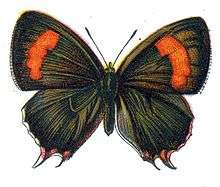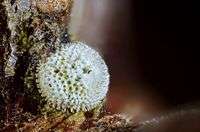Brown hairstreak
| Brown hairstreak | |
|---|---|
| | |
| female | |
_female.jpg) | |
| female, underside, Otmoor, Oxfordshire | |
| Scientific classification | |
| Kingdom: | Animalia |
| Phylum: | Arthropoda |
| Class: | Insecta |
| Order: | Lepidoptera |
| Family: | Lycaenidae |
| Genus: | Thecla |
| Species: | T. betulae |
| Binomial name | |
| Thecla betulae (Linnaeus, 1758) | |
The brown hairstreak (Thecla betulae) is a butterfly in the family Lycaenidae. The range includes most of the Palaearctic.
Subspecies
 Female |
- T. b. betulae Europe, N.Caucasus, Saur, Tarbagatai, Dzhungarsky Alatau, Siberia, Amur, Ussuri. Larva on Prunus spinosa, (Caucasus) Crataegus sanguinea, (S.Altai,Saur)
- T. b. crassa Leech, 1894 S.Ussuri Larva on Padus asiatica, Armeniaca mandschurica
- T. b. ongodai Tutt Altai
- T. b. coreana (Nire, 1919) Korea Larva on Fabaceae
- T. b. elwesi Leech, 1890 West China, Central China
- T. b. yiliguozigounae Huang & Murayama, 1992 China
Appearance and behaviour

A little butterfly that is found along hedges, scrub, and wood edges but is often overlooked since it spends much of its time high in the tree canopy. Like the purple emperor this butterfly uses 'master trees', usually European ash Fraxinus excelsior. Males and unmated females congregate at the tops of isolated trees. Once mated the female descends to lower levels to begin laying her eggs. males rarely descend and both feed mainly on honey dew. Both sexes are dark brown on the upperside with orange tails. The female also has a bright orange band across both forewings. The undersides are similar in both sexes and are bright orange with two white streaks.
Lifecycle and foodplants

In Europe the female lays her eggs on blackthorn Prunus spinosa in late August which overwinter, hatching the following spring when the buds are breaking. It has been found that the best way to find breeding sites for this species is to look for the conspicuous white eggs in the winter. The larvae are extremely well camouflaged and feed only at night, remaining motionless during the day. Pupation takes place in leaf litter on the ground in late June or early July and are attractive to ants who will bury them in shallow cells.
See also
References
- Asher, Jim, Martin Warren, Richard Fox, Paul Harding, Gaile Jeffcoate & Stephen Jeffcoate (Eds), 2001. The Millennium Atlas of Butterflies in Britain and Ireland. Oxford University Press.
- Thomas, J.A. & A.M. Emmet, 1990. THECLA BETULAE (Linnaeus). Pages 123–126 in A. Maitland Emmet, John Heath et al. (eds) The Butterflies of Great Britain and Ireland. The Moths and Butterflies of Great Britain and Ireland Vol. 7, Part 1 (Hesperiidae to Nymphalidae). Harley Books, Colchester, UK.
External links
- Butterfly Conservation page for Brown Hairstreak
- UK Butterflies web-page for Brown Hairstreak—including numerous images of all stages
- Field notes from a research study
- Butterfly-guide.co.uk entry
- Image of female underside
- Brown Hairstreak (upperwing)
- Brown Hairstreak (underwing)